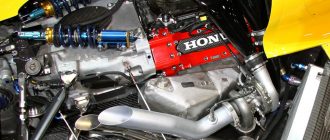What Type of Engines Are in F1 Cars?
Formula 1 cars are the pinnacle of motorsport, and their engines are some of the most powerful and efficient in the world. But what type of engines are they, and how do they work?
1.6-Liter Turbocharged V6 Hybrids
Since 2014, F1 cars have been powered by 1.6-liter turbocharged V6 hybrid engines. These engines are a significant departure from the previous generation of naturally-aspirated V8 engines, and they offer a number of advantages.
The turbocharger helps to increase the engine’s power output by forcing more air into the cylinders. This results in a more powerful and efficient engine. The hybrid system also helps to improve fuel efficiency by recovering energy from the brakes and exhaust gases.
Here are some of the key specifications of the current F1 engines:
- Displacement: 1.6 liters
- Number of cylinders: 6
- Configuration: V6
- Turbocharger: Single turbocharger
- Hybrid system: Motor generator unit-kinetic (MGU-K) and motor generator unit-heat (MGU-H)
- Maximum power output: 1,000 horsepower
- Maximum torque: 600 Nm
- Fuel consumption: 100 kg/h
How Do F1 Engines Work?
F1 engines are incredibly complex machines, but their basic operation is similar to that of any other internal combustion engine. The engine consists of a number of cylinders, each of which contains a piston. The pistons are connected to a crankshaft, which converts the up-and-down motion of the pistons into rotary motion.
The air-fuel mixture is drawn into the cylinders through intake valves. The valves are then closed, and the piston compresses the air-fuel mixture. The spark plug then ignites the air-fuel mixture, causing it to burn. The expanding gases from the combustion process drive the piston down, which in turn rotates the crankshaft.
The turbocharger helps to increase the engine’s power output by forcing more air into the cylinders. The hybrid system also helps to improve fuel efficiency by recovering energy from the brakes and exhaust gases.
The Future of F1 Engines
The future of F1 engines is uncertain. The current 1.6-liter turbocharged V6 hybrid engines are very efficient, but they are also very complex and expensive. There is a growing movement within F1 to switch to a more sustainable fuel source, such as biofuels or electricity.
Whatever the future holds, one thing is for sure: F1 engines will continue to be some of the most powerful and efficient in the world. These engines are a testament to the engineering prowess of the men and women who work in Formula 1.




